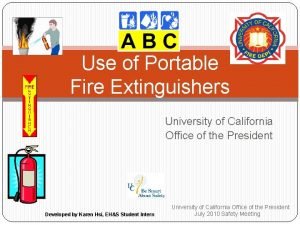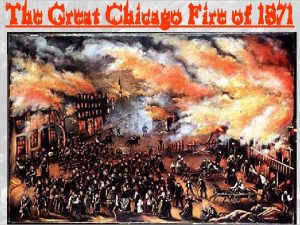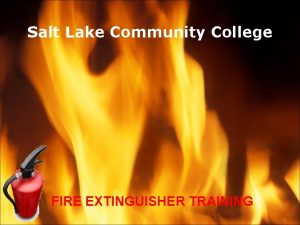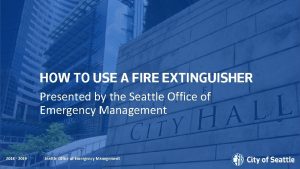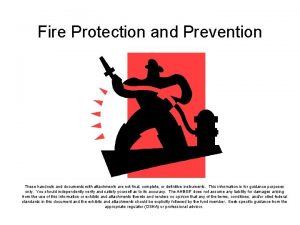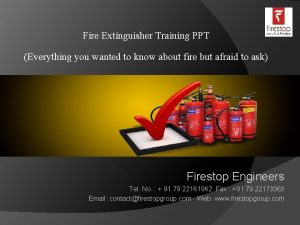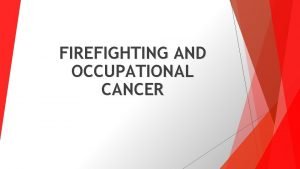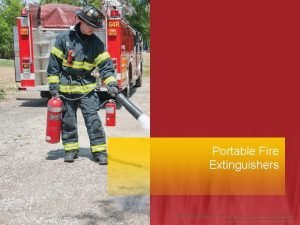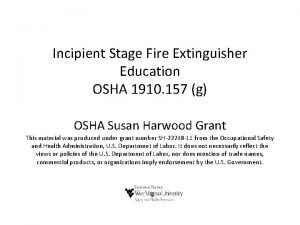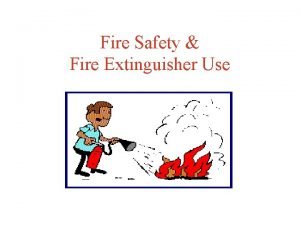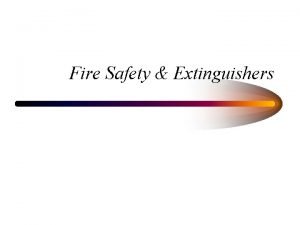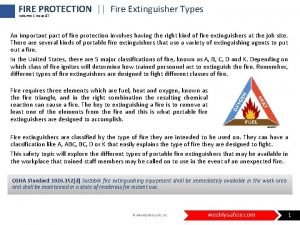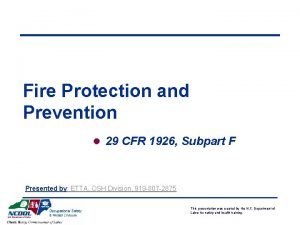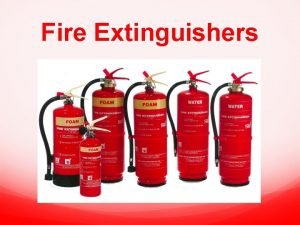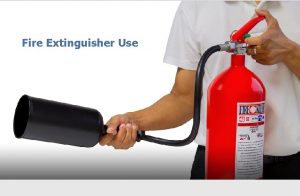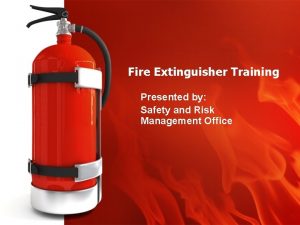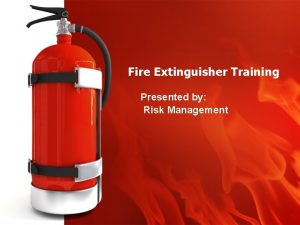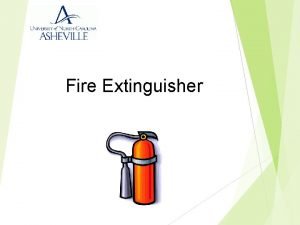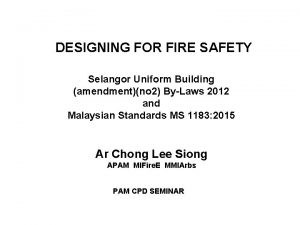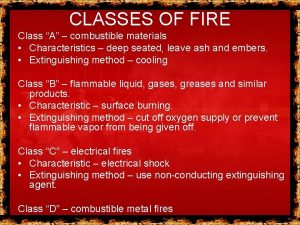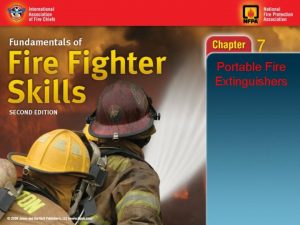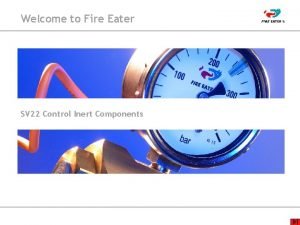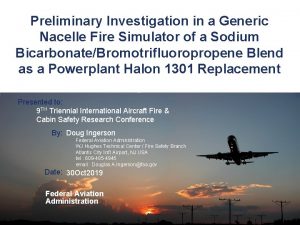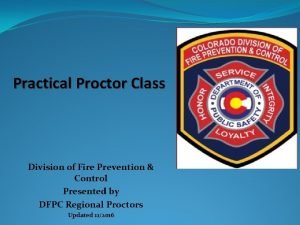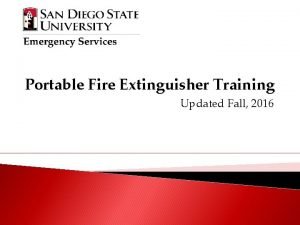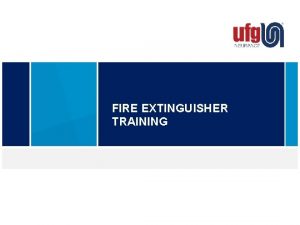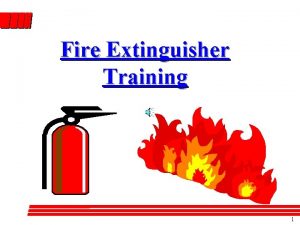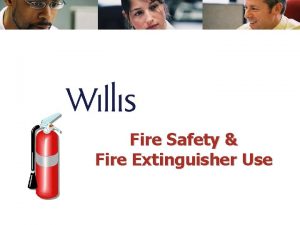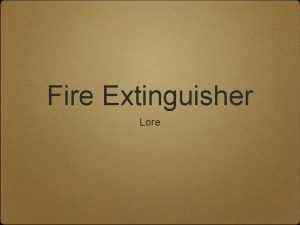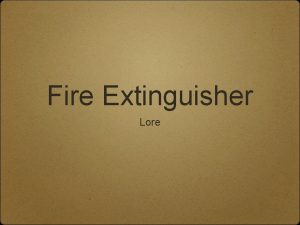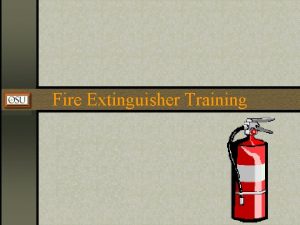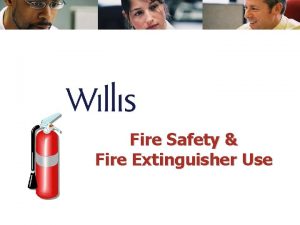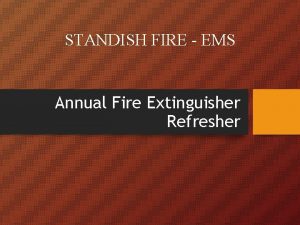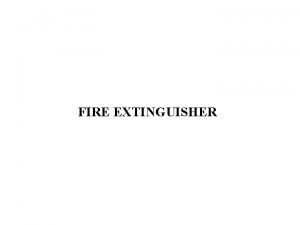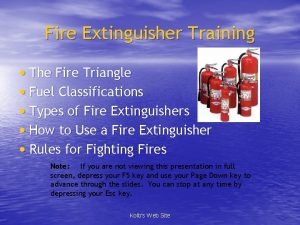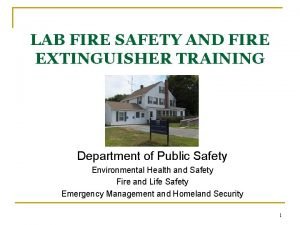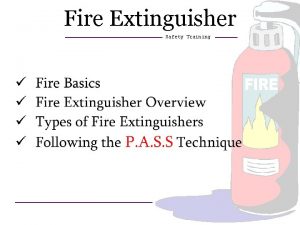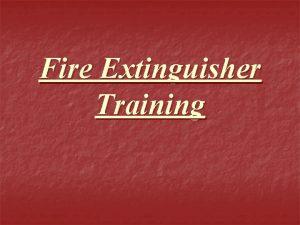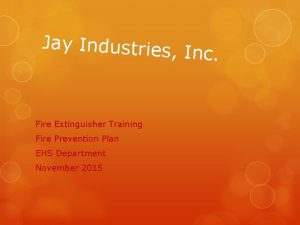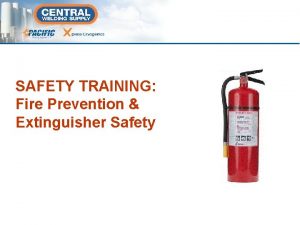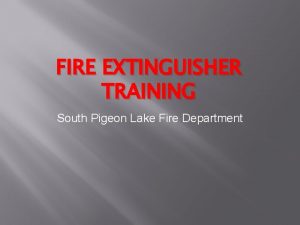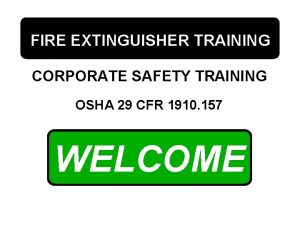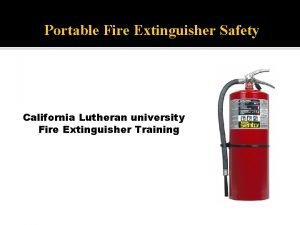Fire Extinguisher Training Fire Extinguisher Training The Fire


























- Slides: 26

Fire Extinguisher Training

Fire Extinguisher Training • The Fire Triangle • Classes of Fires • Types of Fire Extinguishers • Rules for Fighting Fires • How to Use a Fire Extinguisher

The Fire Triangle

The Fire Triangle In order to understand how fire extinguishers work, you first need to know a little bit about fire. Fire is a chemical reaction involving rapid oxidation (burning) of a fuel. Three things must be present at the same time in order to produce fire: FUEL - any combustible material - solid, liquid or gas. Most solids and liquids must vapourise before they will burn. OXYGEN - Sufficient oxygen must be present in the atmosphere surrounding the fuel for the fire to burn. HEAT- Sufficient heat energy must be applied to raise the temperature of the fuel for it to ignite. Essentially, fire extinguishers put out fire by taking away one or more elements of the fire triangle.

Classes of Fire NOT ALL FIRES ARE THE SAME If you use the wrong type of fire extinguisher on the wrong class of fire, you can, in fact, make matters worse. It is therefore very important to understand the six different classes of fires.

Classes of Fire If any one component of the fire triangle (heat, oxygen or fuel) is removed from the fire then the fire will be extinguished. The type of fuel determines which component can be removed the most efficiently. Fires are divided into classes to ensure that the most efficient extinguishing method is used for any particular fire. If you use the wrong type of extinguisher on the wrong class of fire, you may make matters worse. I. e. if water is used to extinguish an oil fire, the oil may float on the water and spread the fire to other areas. Fires are normally classified according to the fuel involved, however, any fire that involves energised electrical equipment is always classified as a class (E) until the electrical circuit is disconnected. It is then reclassed according to the type of material that is burning.

Classes of Fire Class A - ordinary combustible or fibrous material such as wood, paper, fabric, coal, leather, sugar, rubber and some plastics. Class B - flammable liquids such as petrol, kerosene, alcohol, oil and paint thinners. Class C - Flammable Gasses such as LPG, Butane, Acetylene, Hydrogen, natural gas and methane. Class D - Combustible Metals: potassium, sodium, lithium, aluminium, magnesium and metal swarf. Fires of this class may occur in laboratories or industries that use these materials. Metal swarf fires may occur in machine shops where metal turning or milling is carried out. These fires burn at high temperatures and give off sufficient oxygen to support combustion. They may also react violently with water or other chemicals. Class E - Electrical Hazards. Fires involving live electrical equipment (e. g. computers, switchboards and power tools). As long as it's "plugged in, " it would be considered a class (E) fire. If the electricity supply to the equipment is disconnected (plug pulled out), then the fire is not class (E). It takes the class of the fuel that is burning Class F - Cooking Oil or Fat Most fire extinguishers will have a pictograph label telling you which fuels the extinguisher is designed to fight.

Types of Extinguishers The three most common types of fire extinguishers are: • Water, • Dry Chemical Powder (DC), and • Carbon Dioxide (CO 2) Other less common extinguisher types are: - Foam and Wet Chemical

Water Extinguishers Water or APW (air pressurised water) extinguishers are large, red extinguishers, filled about two-thirds with ordinary tap water and then pressurized with air. When the extinguisher is activated a stream of water is forced out the nozzle. This type of extinguisher removes the "heat" element of the fire triangle.

Water Extinguishers Water (APW) Extinguishers are designed for Class A (wood, paper, cloth) fires only. Never use water to extinguish flammable liquid fires. The burning liquid may float and spread out on the water surface thus spreading the fire. Never use water to extinguish an electrical fire. Water is a good conductor, and there is a high risk that you may receive a severe electric shock if you use water on an electrical fire. Electrical equipment must be unplugged and/or de-energized before using a water extinguisher on it.

Carbon Dioxide Extinguishers Carbon Dioxide extinguishers are filled with non-flammable carbon dioxide gas under extreme pressure. The pressure in the cylinder is so great that when you use one of these extinguishers, bits of dry ice may shoot out the nozzle. They extinguish the fire by displacing the air and thus removing the oxygen. They also provide some cooling of the fire. You can recognize a CO 2 extinguisher by its black band on a red body and a large wide nozzle shield (horn) on the end of a flexible hose. These extinguishers are frequently used in laboratories and other areas where flammable liquids or sensitive electrical instruments are stored or used. Use on A, B and E class Fires

Dry Chemical Powder Extinguishers These extinguishers are filled with a fine powder and pressurised by nitrogen. When activated they extinguish a fire by coating the fuel with a thin layer of powder, this separates the fuel from the oxygen and the powder also interrupts the chemical reaction of fire. They are extremely effective. Dry Chemical powder extinguishers are identified by a white band on a red body.

Dry Chemical Powder Extinguishers Dry Chemical Extinguishers come in two types. You may see them labelled: "AB(E)" indicating that they are designed to extinguish class A, B, and (E) fires, or "B(E)" indicating that they are designed to extinguish class B and (E) fires but NOT class A. Either one may be used for a class C (flammable gas) fire after the source of gas is turned off and, or a class F (cooking oil or fat) fire. It is important to identify which types of dry chemical extinguishers are located in your area. OR A B E

Rules for Fighting Fires FIRES ARE DANGEROUS You must always be sure that you do not place yourself or anyone else at risk if you decide to try and extinguish a fire. These rules will help you make a safe decision if you discover a fire at home or your workplace. • Assist any person in immediate danger, to get to safety, if this can be accomplished without risk to yourself • Call the Fire brigade by dialling 000, and alert people in the vicinity that there is a fire in the building by calling out or activating a fire alarm. (Enlist the help of others to ensure that everyone knows there is a fire). • Ensure all people in the building are aware of the emergency and are starting to move out. Only after having done these three things, and if the fire is small, should you attempt to use an extinguisher to put it out.

Rules for Fighting Fires IF YOU DECIDE TO FIGHT THE FIRE, KEEP THESE RULES IN MIND Operate the extinguisher briefly as you approach the fire, to ensure that it is working properly. (With dry chemical powder type extinguishers it is possible that when initially operated, the powder may not allow the valve to fully close again, therefore you should be approaching the fire when you test the extinguisher. ) Obtain assistance if possible before you fight the fire. Ensure that there is a clear escape path behind you at all times

NEVER ATTEMPT TO FIGHT A FIRE IF: You don't know what is burning. - You don't know what type of extinguisher to use or what other hazards to expect. There may be something burning that will explode or perhaps produce toxic fumes. Let the fire brigade handle it. The fire has started to spread rapidly. A portable extinguisher is only useful for small fires. If the fire is already spreading quickly, it is best to simply close the doors and windows to slow down the spread of the fire and evacuate the building.

NEVER ATTEMPT TO FIGHT A FIRE IF: You don't have adequate or appropriate equipment. If you don't have the correct type or large enough extinguisher, it is best not to try to fight the fire. (Always test the extinguisher to ensure it is serviceable before you go near to the fire). You might inhale toxic smoke. If the fire is producing large amounts of smoke (that you are breathing in), it is best not to try. Any sort of combustion will produce some amount of carbon monoxide, but when synthetic materials e. g. nylon in carpeting, paint or foam padding, they can produce highly toxic gases -hydrogen cyanide, carbon monoxide etc. These gases can be fatal in very small amounts. Your instincts tell you not to. If you are uncomfortable with the situation for any reason, just let the fire service do their job.

REMEMBER THE FINAL RULE • ALWAYS POSITION YOURSELF WITH AN EXIT OR MEANS OF ESCAPE AT YOUR BACK BEFORE YOU ATTEMPT TO FIGHT A FIRE. • YOU MAY NEED TO BE ABLE TO GET OUT QUICKLY. • YOU DON'T WANT TO BECOME TRAPPED.

How to Operate an Extinguisher It's easy to remember how to use a fire extinguisher if you can remember the acronym PASS Pull, Aim, Squeeze, and Sweep.

How to Operate an Extinguisher Pull the pin. This will allow you to operate the extinguisher

How to Operate an Extinguisher Aim at the base of the fire. This is where the fuel is

How to Operate an Extinguisher Squeeze the top handle or lever. This releases the pressurised extinguishing agent in the extinguisher.

How to Operate an Extinguisher Sweep from side to side. Until the fire is completely extinguished. Start using the extinguisher from a safe distance away, then move forward as the fire diminishes. Once the fire is out, keep an eye on the area just in case it re-ignites. Sweep from side to side



QUESTIONS
 Cal osha fire extinguisher requirements
Cal osha fire extinguisher requirements Fire extinguisher training chicago
Fire extinguisher training chicago Community
Community Fire extinguisher anatomy
Fire extinguisher anatomy Fire extinguisher training handout
Fire extinguisher training handout Osha fire extinguisher training powerpoint
Osha fire extinguisher training powerpoint Fire extinguisher training winnipeg
Fire extinguisher training winnipeg Fire extinguisher anatomy
Fire extinguisher anatomy Fire extinguisher basics
Fire extinguisher basics Osha 1910 fire extinguisher
Osha 1910 fire extinguisher Pull the pin
Pull the pin Ordinary combustibles or fibrous materials
Ordinary combustibles or fibrous materials Class of fire
Class of fire Osha 1926 fire extinguisher
Osha 1926 fire extinguisher Fire extinguisher race pass
Fire extinguisher race pass Fire extinguisher types
Fire extinguisher types Apw extinguisher
Apw extinguisher Kfc fire safety test answers
Kfc fire safety test answers Fire extinguisher pull
Fire extinguisher pull Fire extinguisher rules osha
Fire extinguisher rules osha Ubbl fire extinguisher
Ubbl fire extinguisher Characteristic of class c fire
Characteristic of class c fire Fire extinguisher objectives
Fire extinguisher objectives Is-2
Is-2 Btp fire extinguisher
Btp fire extinguisher Proctor fire extinguisher
Proctor fire extinguisher Class c fires
Class c fires
